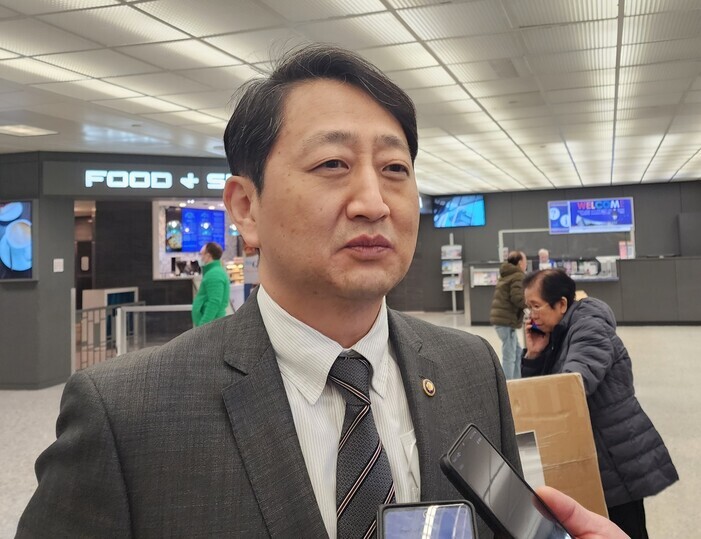hankyoreh
Links to other country sites 다른 나라 사이트 링크
S. Korea’s trade minister voices concern over US semiconductor subsidy criteria

On a visit to the US to discuss concerns of fallout from American semiconductor policies for South Korean chipmakers, Trade Minister Ahn Duk-geun said of US policy that there are portions that “could be quite problematic.” While the US is emphasizing “economic security” through cooperation with its allies, a sense that South Korea’s economic interests are being threatened has spurred Seoul to act fast.
Ahn met reporters at an airport near Washington on Wednesday (local time). When asked to respond to the US Commerce Department’s recent unveiling of the criteria for a US$39 billion subsidies program for semiconductor production facilities, he stated that he came to consult relevant parties about that plan.
“We have concerns, and there are many circumstances in our industry that we need to take into account,” the trade minister said.
Ahn stated that the criteria “requests excessive information and imposes a lot of restrictions regarding business with China and excess profits.” He said that the criteria went too far in requiring companies to disclose production facilities and raw materials, which could include trade secrets, and submitting lists of major customers.
The US Department of Commerce previously announced that if a company earns more profits than originally forecasted, it will withhold no more than 75% of the subsidy. Another troubling provision is that subsidy recipients are prohibited from expanding production capacity in China for 10 years. This directly affects Samsung Electronics and SK Hynix, with both companies having production facilities in China. The US Department of Commerce plans to issue detailed guidance on such “guardrails” regarding investments in China.
“Semiconductors are a very volatile industry,” Ahn said of the subsidy criteria, “and depending on how it’s implemented, it could be quite problematic.”
Ahn characterized the criteria as “a bit excessive,” adding that this “sets a very bad precedent for investment policies.” The minister for trade told reporters that he would explain South Korea’s position to the US administration and Congress.
The potential damage to South Korean companies from the US’ industrial policies is also expected to be a key agenda item for President Yoon Suk-yeol’s state visit to the US on April 26. The big question is whether the US will extend the one-year waiver on equipment exports to Korean companies’ semiconductor production facilities in China before it expires in October.
Alan Estevez, US Commerce Department’s undersecretary for industry and security, stated on Feb. 23 that memory chipmakers in China will likely face a “cap on the levels that they can grow to in China” after the one-year reprieve from US export restrictions.
Currently in the US to coordinate Yoon’s visit, Kim Sung-han, director of the National Security Office, said on Tuesday that discussions are underway on how to minimize the damage to South Korean companies from the US’ industrial policy.
“The US was quite concerned about how the semiconductor law would affect its allies,” a senior government official shared.
But it is unclear how far the US — which has repeatedly chosen a “wait and see” approach when South Korea, the European Union, Japan and others have asked for redress over discrimination against electric vehicles since the Inflation Reduction Act was enacted in August 2022 — will go to allay South Korea’s concerns.
By Lee Bon-young, Washington correspondent
Please direct questions or comments to [english@hani.co.kr]

Editorial・opinion
![[Column] Season 2 of special prosecutor probe may be coming to Korea soon [Column] Season 2 of special prosecutor probe may be coming to Korea soon](https://flexible.img.hani.co.kr/flexible/normal/500/300/imgdb/original/2024/0426/3317141030699447.jpg) [Column] Season 2 of special prosecutor probe may be coming to Korea soon
[Column] Season 2 of special prosecutor probe may be coming to Korea soon![[Column] Park Geun-hye déjà vu in Yoon Suk-yeol [Column] Park Geun-hye déjà vu in Yoon Suk-yeol](https://flexible.img.hani.co.kr/flexible/normal/500/300/imgdb/original/2024/0424/651713945113788.jpg) [Column] Park Geun-hye déjà vu in Yoon Suk-yeol
[Column] Park Geun-hye déjà vu in Yoon Suk-yeol- [Editorial] New weight of N. Korea’s nuclear threats makes dialogue all the more urgent
- [Guest essay] The real reason Korea’s new right wants to dub Rhee a founding father
- [Column] ‘Choson’: Is it time we start referring to N. Korea in its own terms?
- [Editorial] Japan’s rewriting of history with Korea has gone too far
- [Column] The president’s questionable capacity for dialogue
- [Column] Are chaebol firms just pizza pies for families to divvy up as they please?
- [Column] Has Korea, too, crossed the Rubicon on China?
- [Correspondent’s column] In Japan’s alliance with US, echoes of its past alliances with UK
Most viewed articles
- 1Is Japan about to snatch control of Line messenger from Korea’s Naver?
- 2‘We must say no’: Seoul defense chief on Korean, USFK involvement in hypothetical Taiwan crisis
- 3Up-and-coming Indonesian group StarBe spills what it learned during K-pop training in Seoul
- 4[News analysis] Using lure of fame, K-entertainment agency bigwigs sexually prey on young trainees
- 5[Column] Park Geun-hye déjà vu in Yoon Suk-yeol
- 6Is N. Korea threatening to test nukes in response to possible new US-led sanctions body?
- 7Division commander ordered troops to enter raging flood waters before Marine died, survivor says
- 8S. Korea “monitoring developments” after report of secret Chinese police station in Seoul
- 9Will NewJeans end up collateral damage in internal feud at K-pop juggernaut Hybe?
- 10Report reveals toxic pollution at numerous USFK bases